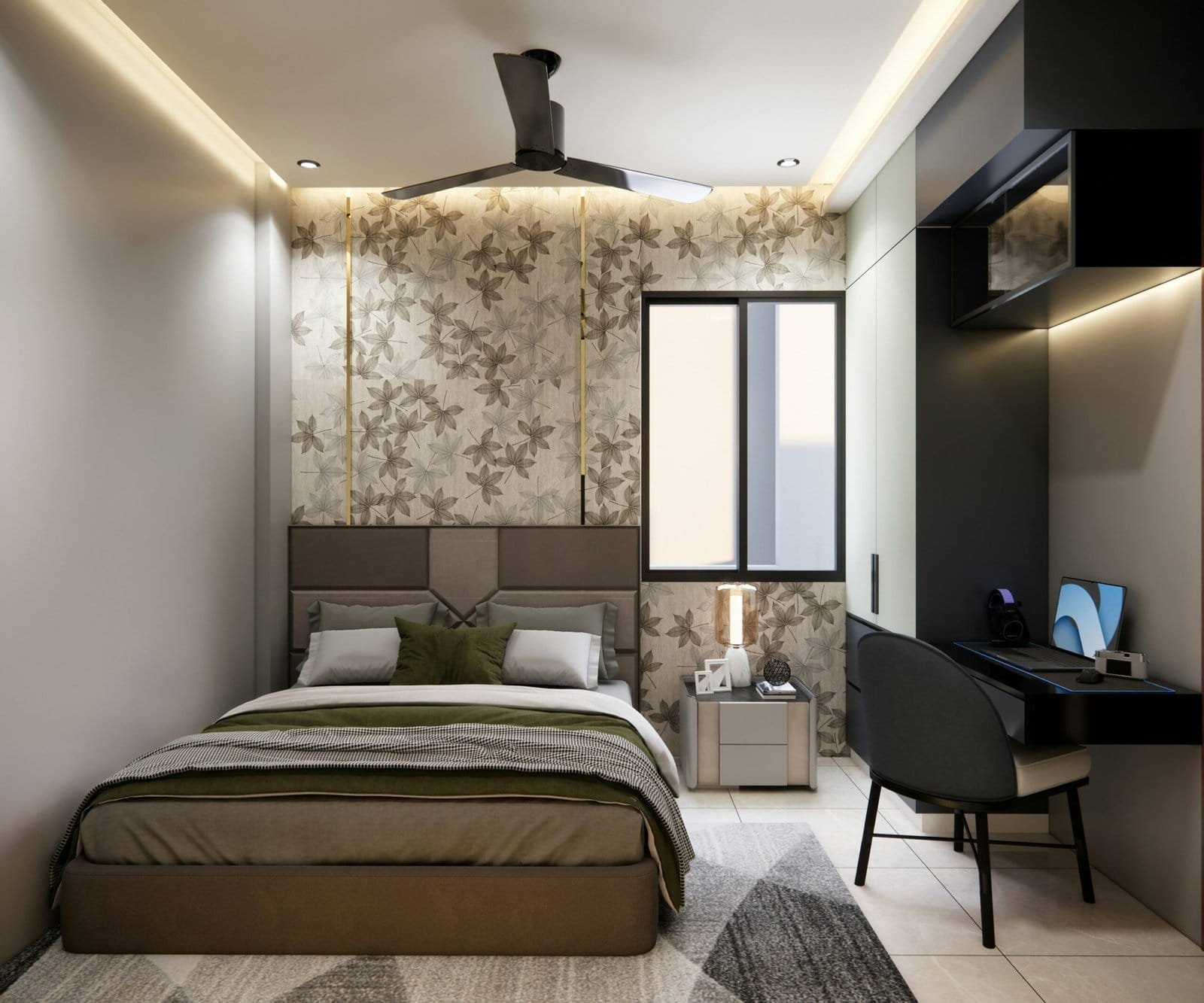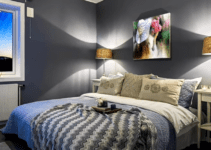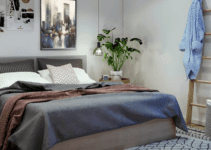Discover the importance of peaceful interiors for better sleep quality through thoughtful bedroom design. This blog post explores color psychology, textures, lighting, and decluttering strategies that create a tranquil atmosphere conducive to relaxation. Learn how to maximize space and incorporate natural elements to transform your bedroom into a serene sanctuary that reflects your personality and promotes overall well-being. Experience 50 fabulous bedroom designs as inspiration for your personal retreat and join the conversation on crafting a restful sleep environment.
Introduction to Peaceful Interiors
In today’s fast-paced world, the significance of peaceful interiors cannot be overstated, especially when it comes to promoting better sleep. Our surroundings play a critical role in influencing our mental and emotional states, particularly during the nighttime hours when the body seeks calmness and relaxation. A restful bedroom environment is not merely a matter of aesthetics but is deeply linked to sleep quality, which in turn affects overall well-being.

Research indicates that approximately one-third of adults experience poor sleep quality, which can be attributed to various factors, including high stress levels and inadequate sleep environments. A study conducted by the National Sleep Foundation reveals that individuals who invest time in creating a tranquil sleeping space report feeling more rested and alert during the day. This emphasizes the need for a thoughtful approach to bedroom design, as it has the potential to impact not only the quantity of sleep we achieve but also its quality.
Please read our article watch the newly uploaded video from our YouTube channel:
“Grig Stamate – Interior Design Solutions”
https://www.youtube.com/@GrigStamate
Peaceful Interiors for Better Sleep, 50 Fabulous Bedroom Designs (video)
Here, you can see other related videos from our channel:
50+ Cozy Bedrooms: Affordable & Chic – A Dreamy Retreat (video)
Taupe Paint Shades: 50 Ideas for Tranquil Bedrooms (video)
Elements such as color schemes, furniture layout, and decor can all contribute to the creation of a serene atmosphere. Soft, muted tones, for example, can evoke feelings of calmness, encouraging relaxation as one prepares for sleep. Additionally, decluttering the space and incorporating elements of nature can further promote tranquility. Anecdotal evidence suggests that individuals who personalize their sleeping environments—with considerations like ambient lighting, comfortable bedding, and soothing scents—tend to experience more restful and restorative nights.
As we delve further into the range of fabulous bedroom designs, it is essential to appreciate the critical role peaceful interiors play in fostering a haven of rest. By prioritizing a harmonious bedroom environment, individuals can create a sanctuary that not only enhances sleep quality but also contributes positively to their overall mental health and emotional clarity.
Color Psychology: Choosing the Right Hues
The concept of color psychology delves into the profound impact that colors can have on our emotions and behaviors. Different hues possess distinctive qualities that can evoke specific feelings, thus playing a crucial role in designing peaceful interiors conducive to better sleep. When considering colors for a bedroom environment, it is essential to select shades that promote calm and relaxation.
For instance, soft blues are often associated with tranquility and serenity. This gentle hue can mimic the sky and calm the mind, making it an ideal choice for creating a restful space. Our showcased bedroom designs feature light blue walls paired with white accents, offering a refreshing yet soothing atmosphere. Additionally, pale greens are reminiscent of nature and can evoke feelings of renewal and peace. Utilizing this color in bedroom decor not only enhances the aesthetic but also contributes to an individual’s overall sense of well-being.
Shades of lavender and soft purples are also known for their calming properties. These colors can help alleviate stress and encourage relaxation, which is essential for a good night’s sleep. Incorporating lavender hues into bedding or wall colors can create a cozy retreat. Other colors such as muted pinks contribute warmth without overwhelming the senses, providing comfort in the bedroom ambiance.
It is important for individuals to consider their own preferences when selecting colors for their personal spaces. A color that offers calmness to one person may not elicit the same response in another. Reflecting on personal experiences and associations with various colors can aid in creating an individualized bedroom sanctuary. What colors do you find soothing? As you explore options for your peaceful bedroom design, contemplating the psychological effects of different hues can significantly enhance your sleep environment.
Creating a Tranquil Atmosphere with Textures
When designing a bedroom intended for restful sleep, the significance of textures cannot be underestimated. Textures play a pivotal role in fostering a sense of comfort and serenity. Different materials evoke varied feelings, and selecting the right elements can transform a space into a sanctuary where one can unwind and recharge. Soft linens, for example, are essential in promoting comfort. Choosing breathable, high-quality bedding such as Egyptian cotton or bamboo blends can enhance the sleeping experience by regulating temperature and providing a gentle touch against the skin.
In addition to linens, plush rugs can significantly contribute to the warmth and coziness of a bedroom. Area rugs made from natural fibers, like wool or jute, provide a comforting surface underfoot while also adding a layer of sound insulation. These textiles not only serve practical purposes but also enrich the visual aspects of the room. Balancing various textures involves considering not just the bedding but also elements like curtains, throws, and cushions. Incorporating soft, textured fabrics for these components can create a harmonious and inviting space.
Natural elements, particularly wood, add a grounded quality to the decor. The combination of wooden furniture, such as nightstands or bed frames, paired with soft textiles encourages a sense of tranquility. Meandering between different textiles, such as mixing a chunky knit throw with smooth satin sheets, can stimulate the senses and create visual interest. When layering textures, attention to color coordination is also important; opting for a cohesive palette that binds the elements together can enhance the overall ambiance. This fluid interaction between different textures encourages a retreat-like atmosphere in your bedroom, promoting better sleep, relaxation, and rejuvenation.
Lighting for a Restful Night’s Sleep
Creating a peaceful bedroom environment is essential for achieving a restful night’s sleep, and lighting plays a crucial role in this process. The right lighting can positively influence our mood and relaxation levels. There are three primary types of lighting to consider: ambient, task, and accent lighting. Each type serves a unique purpose and can be strategically placed to enhance the overall atmosphere of the bedroom.
Ambient lighting serves as the foundation of a room’s illumination, providing general light that creates a cozy atmosphere. Soft, warm light bulbs can invoke calmness and security. Pendant lights, ceiling fixtures, or wall sconces are excellent choices for ambient lighting. Dimmer switches can also be installed, allowing you to adjust the brightness according to your preference and the time of day, promoting better sleep hygiene by gradually dimming light in the evening.
Task lighting is designed for specific activities such as reading or working. Adjustable bedside lamps are excellent examples of task lighting that provide focused illumination without disturbing a partner’s sleep. It’s advisable to choose lamps with shades that diffuse the light, reducing glare and creating a comfortable reading environment.
Accent lighting, on the other hand, adds depth to a room. By highlighting artwork, plants, or architectural features, accent lighting can create an inviting ambiance that enhances relaxation. Consider using LED strips under the bed or behind furniture to offer a soft glow that contributes to a serene atmosphere during nighttime.
Innovative lighting design ideas from featured bedrooms include incorporating layered lighting strategies that combine these three types, allowing for flexibility in creating a tranquil space. Smart lighting technologies can also be integrated, enabling users to customize color temperatures, intensity, and timing to suit individual preferences. Readers can replicate these strategies at home, helping ensure their bedroom becomes a sanctuary for restful sleep.
Decluttering: The Zen Factor
Clutter can significantly impact our mental state and well-being. In a bedroom filled with disorganization, the chaos often translates into a restless mind, making it challenging to achieve restful sleep. Studies have indicated that a cluttered environment can lead to increased stress and anxiety levels, which in turn can hinder our ability to unwind at the end of the day. Conversely, a decluttered bedroom fosters tranquility and encourages a sense of peace, creating an ideal atmosphere conducive to relaxation and sleep.
To achieve a more serene bedroom, start with the basics of decluttering. Begin by categorizing items into three distinct groups: keep, donate, and discard. This process will help to clear unnecessary items and streamline your space. It’s beneficial to tackle one area at a time, whether it’s a single drawer or an entire closet, as this can make the task feel less overwhelming. Another effective method is the “one in, one out” rule; for every new item added to the bedroom, an existing item should be removed. This strategy not only helps maintain organization but also encourages mindful consumption.
Incorporating storage solutions can also ease the burden of maintaining a tidy environment. Decorative boxes or sleek storage bins under the bed can provide a perfect hiding spot for seasonal clothing or infrequently used items. Wall-mounted shelves are another practical addition, offering space to showcase cherished books or decorative pieces without contributing to clutter on surfaces.
Personal anecdotes about the struggle to keep a bedroom organized resonate widely. Many of us have experienced the frustration of a cluttered nightstand filled with unread books and forgotten trinkets. These small, humorous moments often serve as a reminder of our shared journey toward cultivating an organized space, prompting reflection on our own environments and encouraging us to take steps towards creating a peaceful sanctuary for better sleep.
Incorporating Nature: Biophilic Design
Biophilic design is an innovative approach to interior design that emphasizes the connection between human beings and the natural environment. By integrating elements of nature into bedroom interiors, one can enhance tranquility and promote a restful atmosphere conducive to better sleep. This concept recognizes that natural elements such as plants, light, and organic materials have a profound impact on wellbeing and relaxation.
One effective strategy to incorporate biophilic design into a bedroom is through the use of indoor plants. Plants not only purify the air but also add vibrant colors and organic shapes that can have a calming effect. Consider low-maintenance options like snake plants, peace lilies, or pothos, which thrive in indoor conditions and contribute to a serene environment. Placing these plants strategically on bedside tables, windowsills, or in decorative pots can draw the eye and create a visually appealing space.
In addition to greenery, maximizing natural light is crucial for a relaxing bedroom setting. Large windows that invite sunlight during the day can help regulate the body’s internal clock, promoting better sleep patterns. Using sheer curtains or blinds can allow for soft, diffused light to enter the space, creating a warm ambiance. If natural light is limited, consider using artificial lighting that mimics the natural spectrum to maintain that connection to the outdoors.
Furthermore, incorporating organic materials such as wood, stone, and cotton can enhance the authenticity of your sleep space. Natural textures and finishes will not only foster an inviting environment but also create a sense of comfort and serenity. Think about furniture made from reclaimed wood or bedding crafted from organic cotton as substantial additions to your biophilic interior.
As you reflect on your bedroom space, consider how you might invite elements of nature indoors. What are your favorite plants? Each choice contributes to a peaceful sanctuary that encourages relaxation and restful sleep.
Furniture Layout: Maximizing Space and Comfort
Creating a serene sleeping environment is crucial for restful sleep and overall well-being. A well-considered furniture layout can significantly influence the comfort level and the flow of a bedroom, contributing to a peaceful ambiance. When arranging bedroom furniture, it is essential to prioritize space optimization, allowing for ease of movement while also creating inviting areas for relaxation.
One effective approach to maximizing space is to place the bed centrally against a wall, providing balanced access from both sides. This configuration not only facilitates easy entry and exit but also creates a focal point for the room. Additionally, consider the dimensions of other furniture pieces, such as nightstands, dressers, and chairs, ensuring they complement the bed’s placement without overcrowding the space. Selecting furniture with built-in storage options can further optimize the layout while maintaining a tidy atmosphere.
Incorporating functional zones can enhance comfort and flow within the bedroom. For instance, integrating a cozy reading nook by positioning a comfortable chair in a corner with adequate lighting can encourage relaxation and promote better sleep hygiene. Another successful layout design might include a desk area tucked along a wall, making it easy to engage in late-night reading or journaling without compromising sleep space. The balance between functionality and aesthetics is vital when creating a peaceful bedroom atmosphere.
As you explore these various layout strategies, think about your own bedroom arrangements. Are there opportunities to declutter or reconfigure your furniture for improved comfort and serenity? Reflecting on these aspects can inspire a more inviting and restful sleep environment. Striving for a harmonious balance in your layout not only enhances space efficiency but also contributes to the overall tranquility essential for a good night’s sleep.
Personal Touches: Infusing Your Space with Personality
Creating a peaceful bedroom environment is essential to promote restful sleep, and it is equally important that this sanctuary reflects one’s unique personality. Infusing personal touches into your bedroom allows for a harmonious blend between comfort and individuality. Art, decor, and cherished mementos can transform an ordinary space into a personal retreat that exudes warmth and relaxation.
When incorporating art into your bedroom, it’s wise to choose pieces that resonate with your emotions or evoke positive memories. This could include framed photographs that capture significant moments, or art prints that display your favorite colors or styles. These visual elements serve not only as decoration but also as affirmations of your identity, creating a serene atmosphere conducive to restful sleep.
Decorative items such as throw pillows, blankets, and area rugs add softness and character to your space. Opt for textiles and patterns that speak to your taste without overwhelming the calming ambiance. For instance, a simple, understated rug in a calming hue can serve as both a cozy landing for your feet and a subtle expression of style. Additionally, placing a few well-chosen decorative objects, like ceramic vases or unique sculptures, offers a touch of personality, while still maintaining an uncluttered aesthetic.
Mementos from travels or significant life events can further personalize your bedroom. A shell from a favorite beach getaway or a small keepsake from a meaningful experience can serve as daily reminders of happiness and inspiration. When selecting these items, consider their emotional value, ensuring that they contribute positively to the space rather than creating clutter.
Reflect on the items in your bedroom that hold special significance. What do they mean to you? Finding the right balance between personalization and tranquility can create a peaceful haven where restful sleep is not only possible but delightful.
Showcasing 50 Fabulous Bedroom Designs
As we explore the realm of peaceful interiors, we invite you to discover 50 fabulous bedroom designs that are specifically crafted to enhance sleep quality through tranquil aesthetics. Each design showcases unique elements that contribute to a serene atmosphere, making them ideal retreats for relaxation and rest. From minimalist approaches to vibrant yet soothing color palettes, these bedrooms utilize various techniques to promote calmness and rejuvenation.
Among the highlighted designs, soft color schemes such as muted blues, gentle greens, and warm neutrals are predominant, as they foster a soothing environment that encourages sleep. Natural materials like wood, linen, and cotton are also integral, offering texture and comfort while maintaining a sense of warmth. Incorporating elements such as soft, layered bedding, and plush rugs enhances the overall sensory experience, creating an inviting haven for restful nights.
Lighting plays a crucial role in these designs; strategically placed lamps, dimmable overhead fixtures, and soft natural light contribute to a peaceful ambiance. Rooms that are thoughtfully arranged maximize space and minimize clutter, promoting a sense of openness that aids in relaxation. Some designs include peaceful artwork or personalized decor, allowing for individual expression while maintaining harmony within the space. Indoor plants are another key feature, as they not only beautify the room but also purify the air, fostering a healthier sleep environment.
We encourage you to take inspiration from these diverse designs by considering which elements resonate with your personal style. Whether you’re drawn to the calming colors or the use of natural materials, think about how you can incorporate similar vibes into your own bedroom. View each of these 50 fabulous bedrooms as an opportunity to create your personal sanctuary, designed specifically for better sleep and tranquility.
Conclusion and Call to Action
Creating a peaceful bedroom environment is essential for fostering quality sleep. Throughout this blog post, we have explored 50 captivating bedroom designs that prioritize tranquility and comfort. The right combination of color palettes, textures, and furnishings can significantly influence your sleep quality. By emphasizing soothing tones such as soft blues, greens, and neutrals, you can cultivate a serene atmosphere conducive to relaxation. Additionally, incorporating elements like comfortable bedding, gentle lighting, and minimalistic decor can further enhance the peaceful ambiance of your bedroom.
It is vital to recognize that a well-designed bedroom goes beyond aesthetic appeal; it plays a crucial role in promoting restful nights. The synergy between design and functionality is paramount in ensuring that your sleep space supports your need for rejuvenation. Whether it is through investing in blackout curtains, utilizing calming scents, or selecting furniture that promotes ease of movement, each aspect contributes to an environment that nurtures better sleep.
We encourage you to take the insights gained from our exploration of bedroom designs and apply them to your space. Consider how you can implement some of the design principles discussed in this post, and let your creativity flow as you construct your ideal sleep sanctuary. It is your opportunity to craft a bedroom that not only reflects your personal style but also prioritizes your well-being.
We invite our readers to share their own bedroom decor stories, favorite designs, and any tips they may have for cultivating a tranquil sleep environment. Your experiences and insights can inspire others on their journey to creating peaceful interiors. Join us in this creative dialogue and contribute to a community dedicated to enhancing the quality of sleep through beautiful design.
Other related posts from our website:
Let’s see here, three of them:
https://howtobuildahouseblog.com/50-cozy-bedrooms-on-a-budget-affordable-ideas-for-your-dream-space/
https://howtobuildahouseblog.com/plants-in-the-bedroom-create-a-better-indoor-environment/
https://howtobuildahouseblog.com/taupe-paint-shades-50-ideas-for-tranquil-bedrooms/
Thank you so much for your attention.
We also sincerely hope you like our ideas from this post, and you have also enjoyed our uploaded YouTube video.
See you next time at another article. Thank you so much for your time. Bye now!


